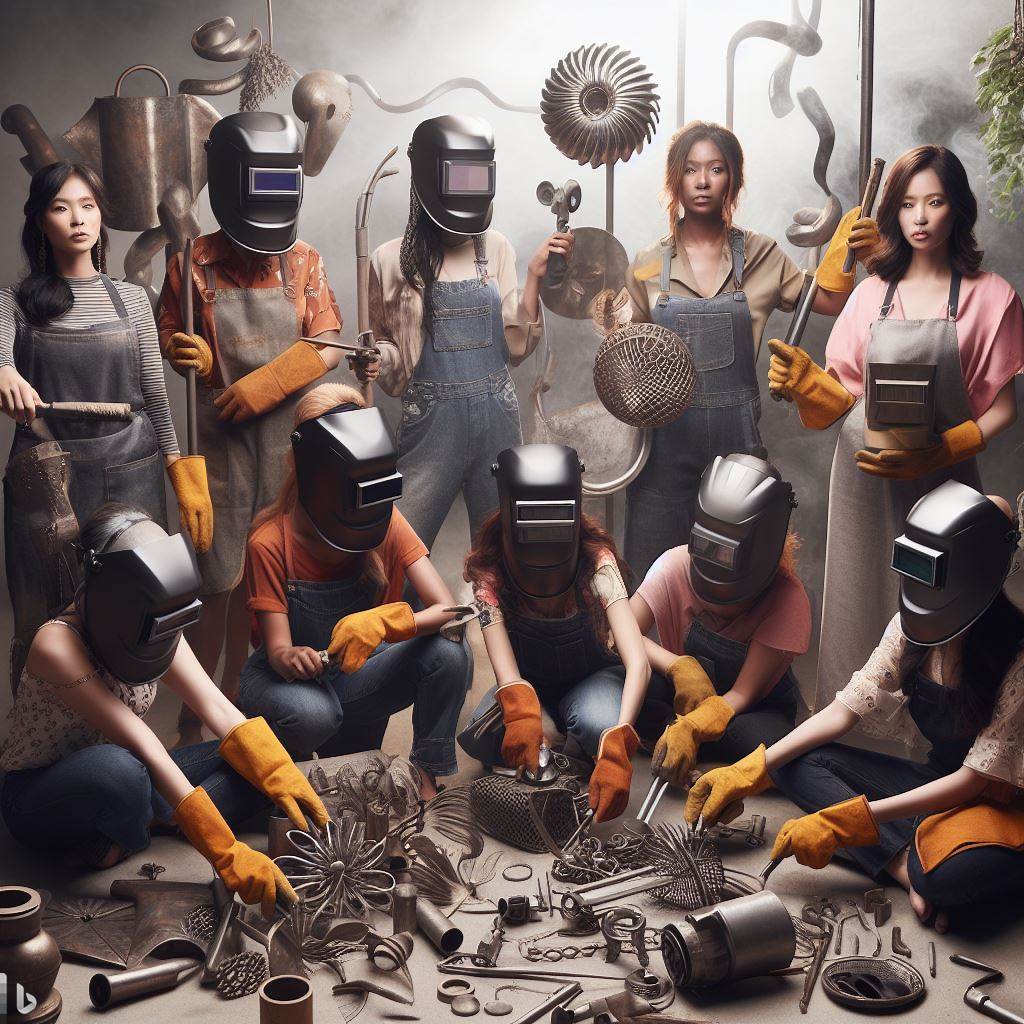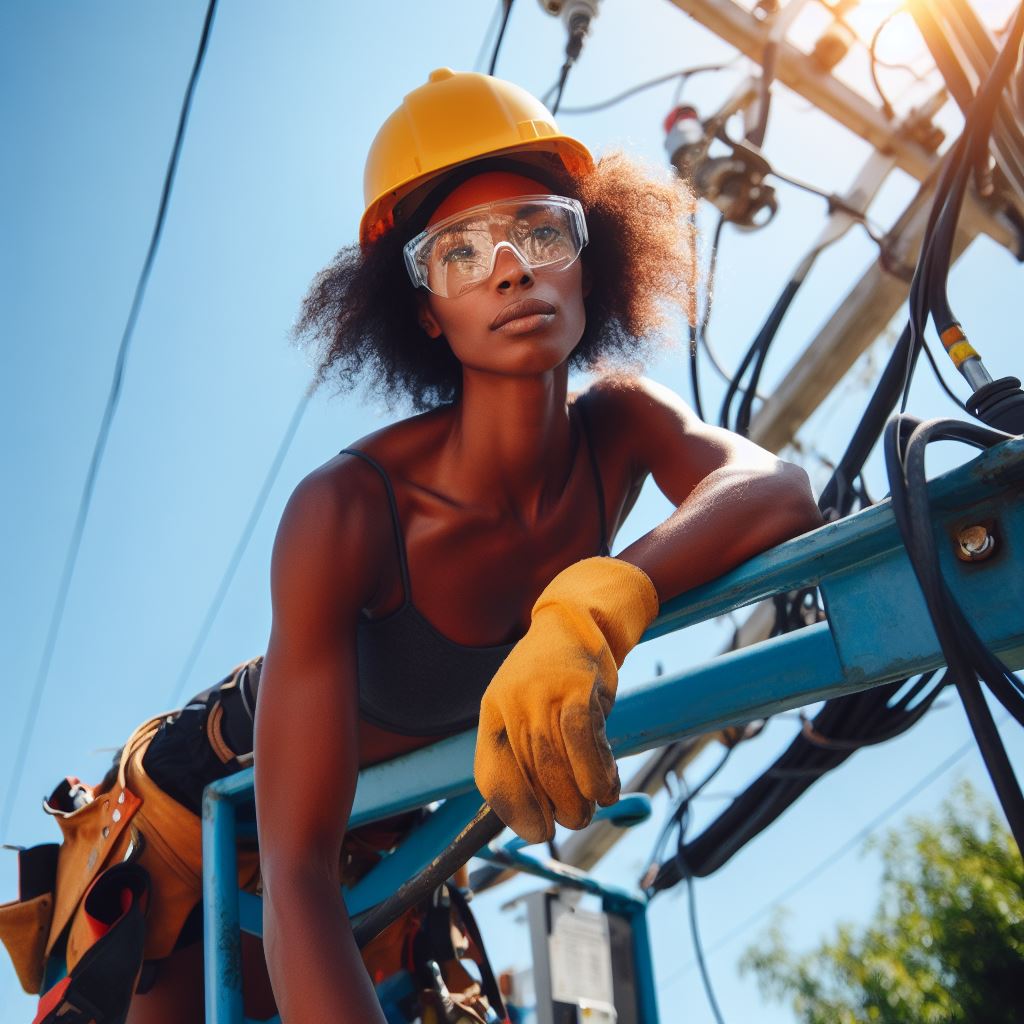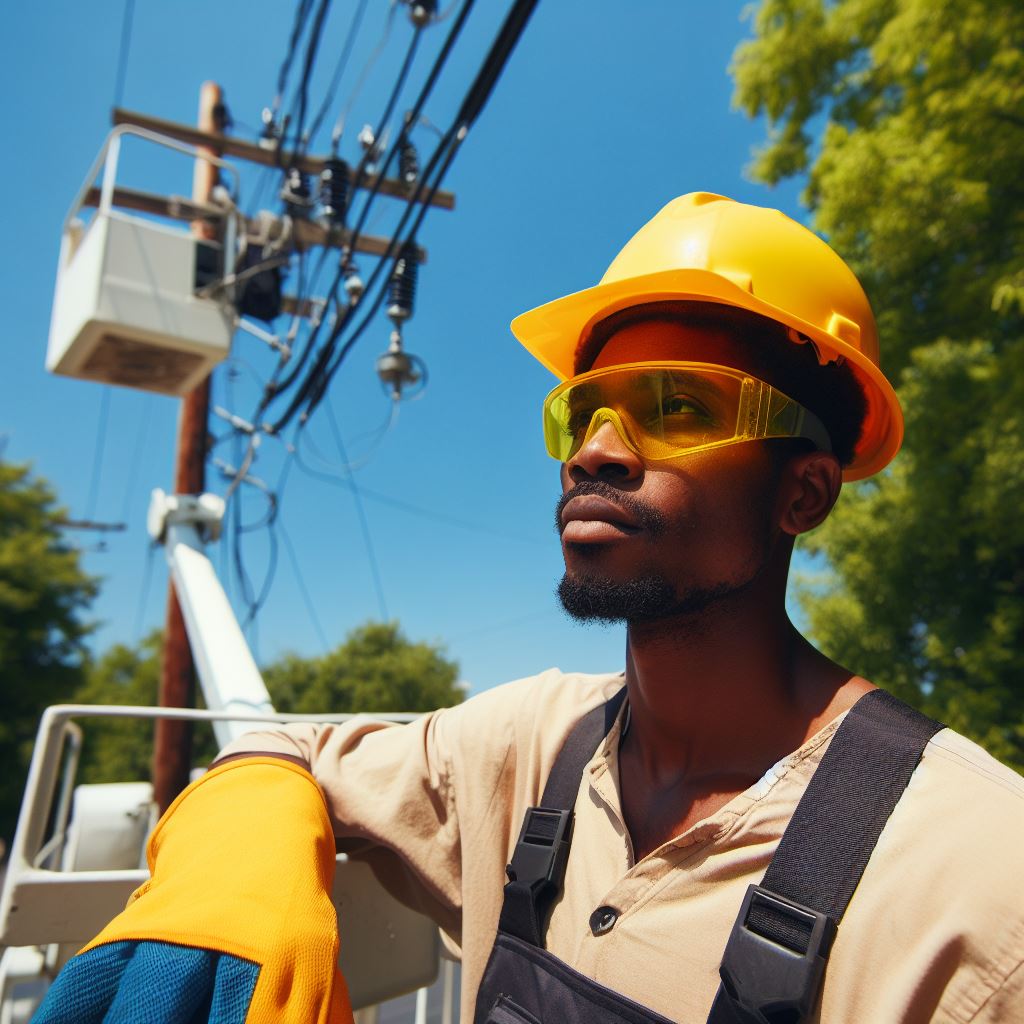Introduction
In today’s society, it is crucial to discuss the role of women in traditionally male-dominated industries, such as welding.
By shedding light on their experiences, we can better understand the importance of gender equality and the need for diverse perspectives in the workforce.
The US welding industry plays a crucial role in various sectors, including construction, manufacturing, and infrastructure development.
It is a thriving industry that offers rewarding careers and technological advancements.
However, for many years, it has been perceived as a male-dominated field, with women often facing barriers and stereotypes that deter them from pursuing welding as a profession.
But times are changing, and the number of women breaking stereotypes in the US welding industry is steadily increasing.
These women are not only challenging traditional gender roles but also defying societal expectations. With their determination, skills, and passion, they are proving that welding is not limited to any gender.
Despite the progress, women in welding still face unique challenges. They encounter skepticism and bias from their male counterparts, and often have to work harder to earn respect and recognition.
However, through their perseverance and dedication, they are transforming the industry, inspiring other women to follow in their footsteps.
In fact, discussing females in the welding profession is important as it showcases their contributions and challenges.
The US welding industry provides ample opportunities for women to excel, and they are breaking stereotypes by proving their worth.
Although barriers still exist, these trailblazing women are paving the way for a more inclusive and diverse workforce. It is time to celebrate their achievements and further empower women in the welding industry.
Historical context of women in welding
Lack of representation and opportunities in the past
Throughout history, women have faced significant barriers in pursuing careers in welding.
They were often excluded from training programs and denied access to job opportunities.
Sexist stereotypes regarding physical strength and capabilities further limited the presence of women in this field.
These obstacles created a significant gender gap in the welding industry, with few women able to break through.
Examples of pioneering women in welding
Despite the challenges, some pioneering women managed to excel in welding, defying societal norms.
One such example is Alice H. Parker, who became the first female welder in the United States Navy during World War II.
Another notable figure is Edith Berg, who established the American Welding Society’s Women’s Committee in 1949.
These women and others paved the way for future generations of females in the welding industry.
Transform Your Career Today
Unlock a personalized career strategy that drives real results. Get tailored advice and a roadmap designed just for you.
Start NowSlow progress towards gender equality in the field
Although there have been notable achievements, progress towards achieving gender equality in welding has been gradual.
Even with increasing awareness and advocacy, women still face numerous challenges in gaining equal opportunities.
The stereotype of welding as a traditionally male-dominated field persists, making it difficult for women to be taken seriously.
Furthermore, workplace discrimination and the lack of inclusive policies continue to hinder women’s advancement in welding.
While some organizations and companies have implemented diversity initiatives, more needs to be done to address these barriers.
Overall, the historical context of females in the welding Profession demonstrates the need for continued efforts to break stereotypes and promote inclusivity.
By celebrating the achievements of pioneering women and advocating for equal opportunities, we can foster a more diverse and equitable welding industry.
Current State of Women in the US Welding Industry
Statistics on the Percentage of Women in the Industry
- Only 5.5% of welders in the US are women, according to the Bureau of Labor Statistics (BLS).
- The American Welding Society (AWS) reports that the number of women involved in welding is slowly increasing.
- Despite the small percentage, the presence of women in welding is becoming more noticeable in recent years.
- The BLS predicts a growth rate of 3% in welding jobs by 2029, providing opportunities for women to enter the field.
Challenges Faced by Women in Welding
- Stereotypes have posed a significant challenge for women aspiring to pursue a career in welding.
- The physical nature of the job, including heavy lifting and long hours, can discourage women from entering the industry.
- Women may face discrimination and lack of support within male-dominated workplaces, limiting their career advancement.
- Limited restroom and changing facilities on job sites can also create obstacles for women.
Initiatives and Organizations Supporting Women in Welding
- The Women in Welding (WIW) program by the AWS promotes and supports women’s involvement in the welding industry.
- Organizations like the National Women in Construction (NAWIC) provide resources and networking opportunities for women in welding.
- Several welding companies have implemented diversity and inclusion programs to attract and retain more women.
- Trade schools and vocational programs are offering scholarships and targeted outreach to encourage women to explore welding careers.
In short, women in the US welding industry face challenges due to stereotypes, the physical nature of the job, and workplace discrimination.
However, initiatives and organizations, such as WIW, NAWIC, and industry-specific programs, are striving to break these stereotypes and provide support to women interested in welding.
Read: Top 10 Cities for Welders in the USA: Where to Work?
Breaking stereotypes: Women’s success stories
In a traditionally male-dominated field like welding, women have emerged as trailblazers, shattering stereotypes and achieving remarkable success.
Let’s explore the profiles of some extraordinary women welders who have defied expectations, overcome obstacles, and made their mark in the industry.
Profiles of successful women welders
Their journey into the industry
One such remarkable woman is Sarah Thompson, who entered the welding industry against all odds.
Growing up, she faced skepticism and discouragement due to her gender.
However, her passion for welding and determination to break barriers drove her to pursue her dreams.
She joined a vocational program and honed her skills, proving that women could excel in a male-dominated field.
Overcoming obstacles and barriers
Another inspiring figure is Maria Rodriguez, who had to surpass societal expectations and stereotypes to establish herself as a successful welder.
She encountered resistance and bias, but her resilience and talent allowed her to overcome these obstacles.
Through hard work and dedication, she earned the respect of her colleagues and became a symbol of empowerment for aspiring women welders.
Achievements and recognition
Emily Collins, a renowned welder, has not only achieved remarkable professional success but also gained recognition for her exceptional skills.
Transform Your Career Today
Unlock a personalized career strategy that drives real results. Get tailored advice and a roadmap designed just for you.
Start NowShe has won several prestigious awards for her craftsmanship and served as an inspiration for women entering the welding industry.
Her achievements have shattered the notion that welding is only suitable for men and have opened doors for countless aspiring female welders.
Impact of these success stories on changing perceptions
The success stories of women welders like Sarah, Maria, and Emily have had a profound impact on changing the perceptions associated with women in welding.
Their accomplishments have debunked the stereotype that welding is a male-only profession, paving the way for more women to explore opportunities in this field.
By sharing their stories and showcasing their expertise, these women have inspired a new generation of female welders.
Young girls who once thought welding was off-limits now see it as a viable career option. The success of these women has encouraged many to challenge societal norms and pursue their passions, regardless of gender.
Furthermore, these success stories have also forced the industry to acknowledge the valuable contributions of women.
With women like Sarah, Maria, and Emily proving their skills and capabilities, companies and organizations are recognizing the importance of promoting diversity in the welding field.
This recognition has led to the establishment of programs and initiatives focused on supporting and empowering women welders, further encouraging their success.
In general, the profiles of successful women welders like Sarah, Maria, and Emily highlight the incredible achievements and impact of women in breaking stereotypes in the welding industry.
Their journeys, overcoming barriers, and recognition have played a significant role in changing perceptions about women’s capabilities in welding.
These success stories have not only inspired aspiring women welders but also prompted the industry to promote diversity and create a more inclusive environment.
Read: The Evolution of Welding in the USA: A Historical Overview

Benefits of increasing diversity in welding
Increasing diversity in the welding industry has numerous benefits that can greatly enhance the overall success of the field.
Through promoting a more inclusive and diverse workforce, the industry can experience improved innovation and problem-solving, an enhanced work environment and teamwork, as well as economic advantages.
Improved innovation and problem-solving
- With a more diverse workforce, there is a wider range of experiences and perspectives.
- This diversity leads to a greater pool of ideas, fostering innovation within the industry.
- Different perspectives can provide unique solutions to welding-related challenges.
- Inclusive environments encourage open communication and collaboration, leading to more effective problem-solving.
Enhanced work environment and teamwork
- A diverse workforce creates a more inclusive and welcoming work environment.
- Employees from different backgrounds enhance the overall cultural competency of the industry.
- Interacting with individuals from diverse backgrounds fosters respect and understanding.
- Increased diversity can lead to improved teamwork and cooperation among employees.
- Working alongside individuals with different perspectives promotes creativity and adaptability.
Economic advantages for the industry
- Increased diversity in welding can lead to a larger and more diverse customer base.
- A diverse workforce can better cater to the needs and preferences of different customer segments.
- Companies that prioritize diversity often have a stronger reputation, attracting more business opportunities.
- Diverse teams are more likely to understand and address the needs of diverse markets.
- Studies have shown that diverse companies tend to have higher financial performance and profitability.
In essence, the benefits of increasing diversity in the welding industry are significant.
From improved innovation and problem-solving to an enhanced work environment and teamwork, promoting diversity can positively impact the industry as a whole.
Additionally, the economic advantages of diversity can lead to increased business opportunities and financial success.
By breaking stereotypes and encouraging more women and individuals from diverse backgrounds to pursue careers in welding, the industry can thrive.
Read: The Legacy of Famous American Carpenters and Their Works
Transform Your Career Today
Unlock a personalized career strategy that drives real results. Get tailored advice and a roadmap designed just for you.
Start NowStrategies to attract more women to the field
Education and vocational training programs
- Develop and promote welding programs specifically tailored for women’s needs and interests.
- Introduce scholarships and financial aid opportunities to support women pursuing welding education.
- Collaborate with schools and educational institutions to incorporate welding into their curriculum.
- Offer flexible learning options such as online or evening classes to accommodate diverse schedules.
- Provide comprehensive training and certification programs to enhance women’s employability in the welding industry.
Encouraging mentors and role models
- Establish mentorship programs where experienced women welders can guide and inspire aspiring female welders.
- Encourage women welders to share their success stories through social media, blogs, and speaking engagements.
- Organize networking events and conferences where women can connect with industry professionals and role models.
- Collaborate with women-led organizations to promote welding as a viable and empowering career choice.
- Showcase successful women welders in promotional materials and campaigns to inspire others.
Promoting the advantages and rewards of a welding career for women
- Highlight the financial stability and earning potential of a welding career to attract women who value financial independence.
- Emphasize the creativity and innovation involved in welding, appealing to women with artistic skills and interests.
- Showcase the diverse range of industries and sectors that require welding skills, providing a wide range of career opportunities.
- Promote the flexibility and work-life balance that welding offers, appealing to women seeking flexible employment options.
- Highlight the satisfaction and pride that comes with creating tangible products and contributing to infrastructure development.
In review, attracting more women to the welding field requires a multifaceted approach.
By implementing targeted education and vocational training programs, providing mentorship opportunities, and promoting the advantages and rewards of a welding career for women, the industry can break stereotypes and create a more inclusive and diverse workforce.
It’s essential for the industry to recognize the potential of women in welding and actively work towards fostering an environment that welcomes and supports their participation.
Read: Building Codes and Standards: Carpenter’s Compliance Guide
Conclusion
Recap of main points discussed
Throughout this blog post, we explored the significant strides made by women in the welding industry in the US.
We highlighted the barriers they have faced and how they have defied stereotypes with their determination and skill.
Positive outlook for the future of women in welding
The future undoubtedly looks bright for women in welding.
With increasing support and recognition, more and more women are entering the field and excelling in their careers.
Their contribution to the industry is invaluable and will continue to grow.
Call to action to support and promote gender equality in the industry
It is crucial for everyone to support and promote gender equality in the welding industry.
By challenging stereotypes, fostering inclusive workplaces, and providing equal opportunities, we can create an environment where women in welding can thrive.
Let us join forces to break down the remaining barriers and ensure that all individuals, regardless of gender, have an equal chance to pursue their passion for welding.
Together, we can shape a future where diversity and equality are the pillars of the industry.
[E-Books for Sale]
The Big Book of 500 High-Paying Jobs in America: Unlock Your Earning Potential
$19.99 • 500 High-Paying Jobs • 330 pages
Explore 500 high-paying jobs in America and learn how to boost your career, earn more, and achieve success!
See All 500 High-Paying Jobs of this E-Book
1001 Professions Without a Degree: High-Paying American Jobs You Can Start Now
$19.99 • 1001 Professions Without a Degree • 174 pages
Discover 1001 high-paying jobs without a degree! Unlock career tips, skills, and success strategies for just $19.99!




